Your Ultimate Guide to OKRs
OnStrategy is here to help your team with everything OKR—from software, consulting, and DIY templates and guides. Tap into our best-of-the-best content to help your organization build, implement, and refresh your plan with Objectives and Key Results.
What is an OKR?
The three-letter acronym – OKR – stands for Objectives and Key Results. OKRs is a goal-setting approach where an Objective outlines the desired outcome and is supported by 3-5 quantifiable and measurable Key Results used to achieve that outcome.
Objectives are what you want to achieve; these are expressive, motivating outcomes. Key Results outline how you’ll achieve that Objective. Key Results are quantifiable business performance measures that create deliverables (effort or projects).
The OKR thought process was popularized by Google and has become one of the most loved methods for agile planning. It helps organizations set ambitious goals and rigorously manage results from the top of an organization down to the individual level.
Get the Free OKR Cheat Sheet
Get the free cheat sheet to guide you through building and refreshing your OKRs, including 29 pro tips from our work with clients.
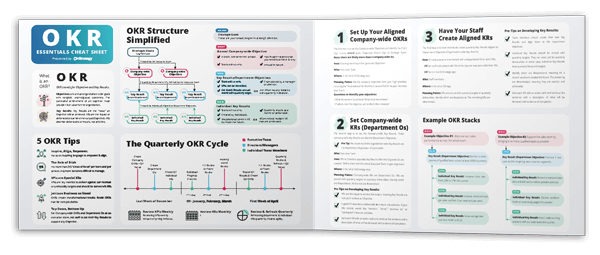
What is an Objective?
Objectives are annual, organization-wide tangible, and measurable goals with unambiguous outcomes. Achieving an Objective provides clear long-term value and helps your organization achieve its vision of success.
Additionally, we recommend that all Objectives align with your long-term vision of success. OKRs can create “puddles” of focus instead of united, directed action to achieve your desired future state without alignment to your vision.
Great objectives should:
- Be a short, one-sentence phrase.
- Start with a verb.
- Have impact–-stating what you need to achieve and why.
- Be annual in nature.
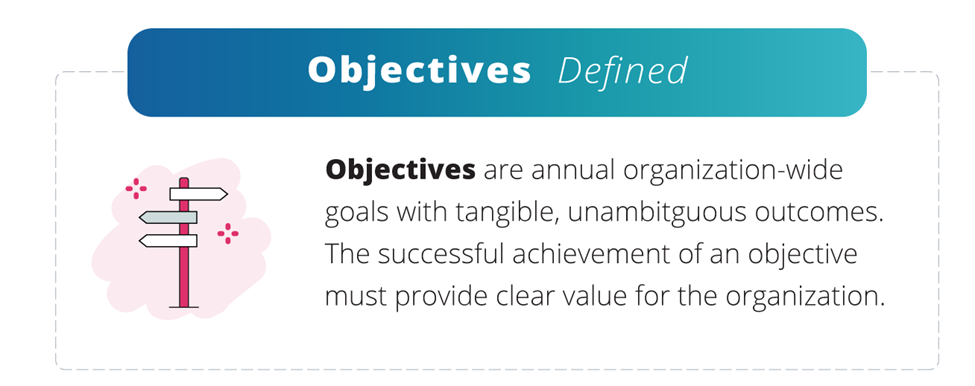
What are Key Results?
Key Results are the “hows” to achieve an objective. Key Results create the actions and deliverables that will achieve your company goals desired output (Objective). Key Results describe deliverables or results, not activities.
Key Results: Performance Measures
These are Key Results that can be measured with quantifiable results. You can also make these Key Results your Key Performance Indicators!
Key Results: Strategic Initiatives
These are project-type Key Results. Deliverables measure the achievement of these Key Results.
Great Key Results should:
- Start with a verb.
- Be owned by a department manager at the department level.
- Be owned by an individual at the individual level.
- Be aspirational – a stretch goal. Or the Key Result is committed–-a realistic key result that is achievable.
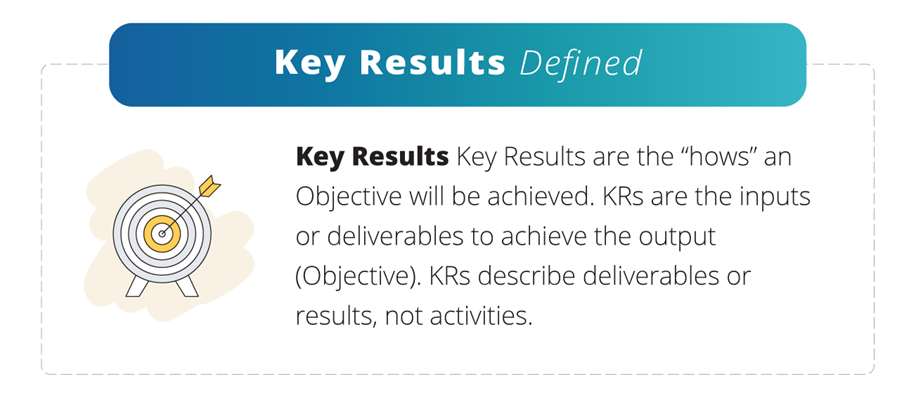
How to Simplify Your OKR Approach
Plenty of resources are available to help you structure your organization’s OKRs. But we have developed an approach to cascading them that is much more straightforward and aligned to your organization’s greater vision of success.
In a traditional OKR approach, every individual creates an entire set of OKRs every quarter. And in practice, this sounds awesome. However, we’ve seen it develop puddles of OKRs that aren’t focused on what your organization is setting out to achieve.
Instead, we’ve recommended using a simplified approach where your leadership team creates a set of shared annual Objectives for the organization and departments. Then, teammates create individual Key Results that align with those Objectives and are refreshed every quarter. It’s the best of both worlds – you create a shared direction and reap the benefits of having your team adapt and refresh the plan quarterly.
Get the Free OKR Essentials Cheat Sheet to reference as you build and structure your OKRs.
Strategic Goals/Objectives
These are your long-term (3-5 year) goals.
Annual Company-wide Objectives
This is how our structure is different. We recommend your organization set annual organization-wide Objectives that state what you need to achieve and what are your organization’s areas of focus. In a traditional OKR format, everyone creates their own Objectives; we prefer shared Objectives to create alignment against your strategic direction.
Key Results/Department Objectives
Key Results at the department level are owned by department leaders. They reflect how each functional team supports annual organization-wide Objectives. To simplify the OKR cascading effort, we recommend these department Key Results become the shared Objectives for which your team creates supporting Key Results.
Individual Key Results
Created by everyone, Key Results define the quarterly focus for those aligned to the department Objective.
Why it Works
This plan structure creates clear shared department Objectives for your team members to create supporting Key Results. And every department Objective supports the organization-wide Objective. Alignment top-to-bottom! You can find more helpful tips on this plan structure in our OKR Essentials Cheat Sheet!
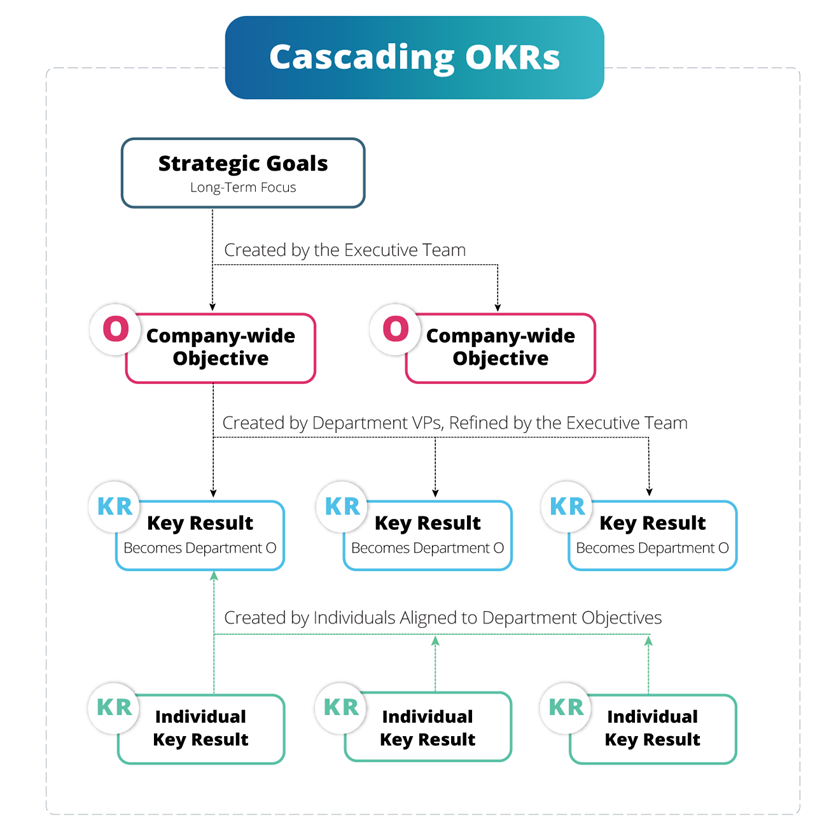
Example
Objective Format: Verb + Impact (What You Need to Achieve & Why) + Year.
Department Key Result (Objective) Format: Verb + Impact to Achieving Annual Objective + Measure. *KPIs are identified here.
Individual Key Result Format: Verb + Quarterly Outcome + Measure.
Objective: Improve our sales performance to grow our customer base and market position in 202X
Key Result (Department Objective): Grow to a sales pipeline of qualified leads valued at least $500K quarterly.
- Individual Key Result: Increase the close rate from 22% to 27% this quarter.
- Individual Key Result: Increase scheduled calls per sales rep from 3 per week to 6 per week.
- Individual Key Result: Increase the average deal size from $10K to $12K.
See a full list of 20 examples for your entire organization here!
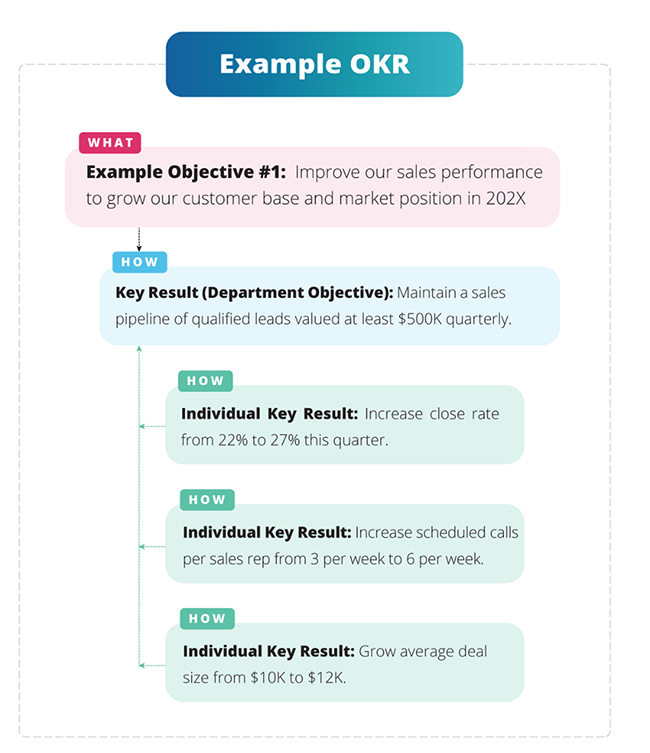
Why Use OKRs?
OKRs are a great way to wrap in all kinds of ideas related to outcomes, accountability, commitments, agility, and the process of connecting individuals to the larger mission and vision of the organization. That’s what we love about OKRs!
But we recommend that OKRs directly support a clear vision of success or direction.
We can’t emphasize this enough because connecting – and staying connected – to a bigger purpose and bold direction inspires self-directed ownership and commitment.
How do you know if the OKR methodology is suitable for your organization? Here are a few considerations.
- Are you ready to engage all staff or at least more than your executive team in organizational performance? OKRs are built for broad engagement. For executive teams only, the methodology is too heavy.
- Do you have a clear strategic direction that can be shared broadly? If not, wait until this is settled to move into this process.
- Do you have too many metrics? Some organizations need to narrow the focus to the “difference makers.” OKRs are perfect for solving this problem.
- Do you have a team culture that is ready to make commitments and manage them? Culture fit is critical to the success of OKRs as a goal setting and management approach. You probably have a sense as to your team’s readiness. Trust your instinct and wait if the unit is not ready.
3 OKR Pitfalls to Avoid
OKRs are an amazing tool to focus your organization and keep everyone engaged on what matters most. But, there are a few pitfalls you should be aware of if you choose to adopt an OKR plan format in your organization.
You can check out a full detailed analysis on fixing agile planning and OKR pitfalls in our free Fix Your Agile Plan Guide here.
OKRs Being Disconnected
If your OKRs feel disconnected or unfocused across your organization, it’s likely because they haven’t been aligned to a set of long-term strategic objectives. We usually recommend every organization create 3+ (but no more than 6) strategic Objectives that are 3-5 years in nature that help set the direction of your organization.
The Solution: Set 3– to 5-year strategic Objectives to set your team’s direction. Then create OKRs to support that same objective and direction. As noted above, we prefer a simplified OKR structure where leadership creates annual companywide Objectives and supports department Objectives. Then, teams create supporting Key Results aligned to the organization’s core Objectives and direction.
PRO TIP:
We like starting with a great vision statement. Check out the cheat sheet on creating a great vision here.
OKRs that are Tactical or Operational
Sometimes after an OKR effort, you’ve created a plan that’s too tactical or operational. After all, OKRs are supposed to stretch your team to achieve a bold direction, not just provide a to-do list.
The solution: Revisit your SWOT analysis and consider what you need to strengthen, fix, or pursue to achieve your desired future state. Using your SWOT as the driving force behind creating the backbone of your OKRs allows you to capitalize on what you’re good at today to improve business performance and help achieve the tomorrow you desire.
PRO TIP:
OKRs are about stretching your organization. As your team develops their OKRs, enter this exercise with that mindset. Think about creating the future instead of just making a to-do list for the quarter.
Plan Full of Unstructured OKRs
If you have an OKR plan that has quality or formatting inconsistencies across teams or individuals, it might be because your team was unclear about how to set good OKRs.
The solution: The best way to fix an unstructured or inconsistent plan is to outline clear standards about how everyone creates their OKRs.
PRO TIP:
If you need guidance and a worksheet to help your team create great OKRs/goals, check out our free guide here.
The OKR Implementation Cycle
The power in OKRs is that they help create a consistent quarterly focus for your team to adapt and refresh your plan. It’s why OKRs help create agility in the organizations that use them.
But where do you start? How do you adopt an agile planning process?
We always recommend using a StrategySprint™ cycle to connect your long-term vision, OKRs, and weekly activities.
In each 90-day period, your team sets quarterly focus, reviews OKRs monthly, then reviews and refreshes your plan at the end of each cycle. Adapt and change while still staying aligned to your long-term vision.
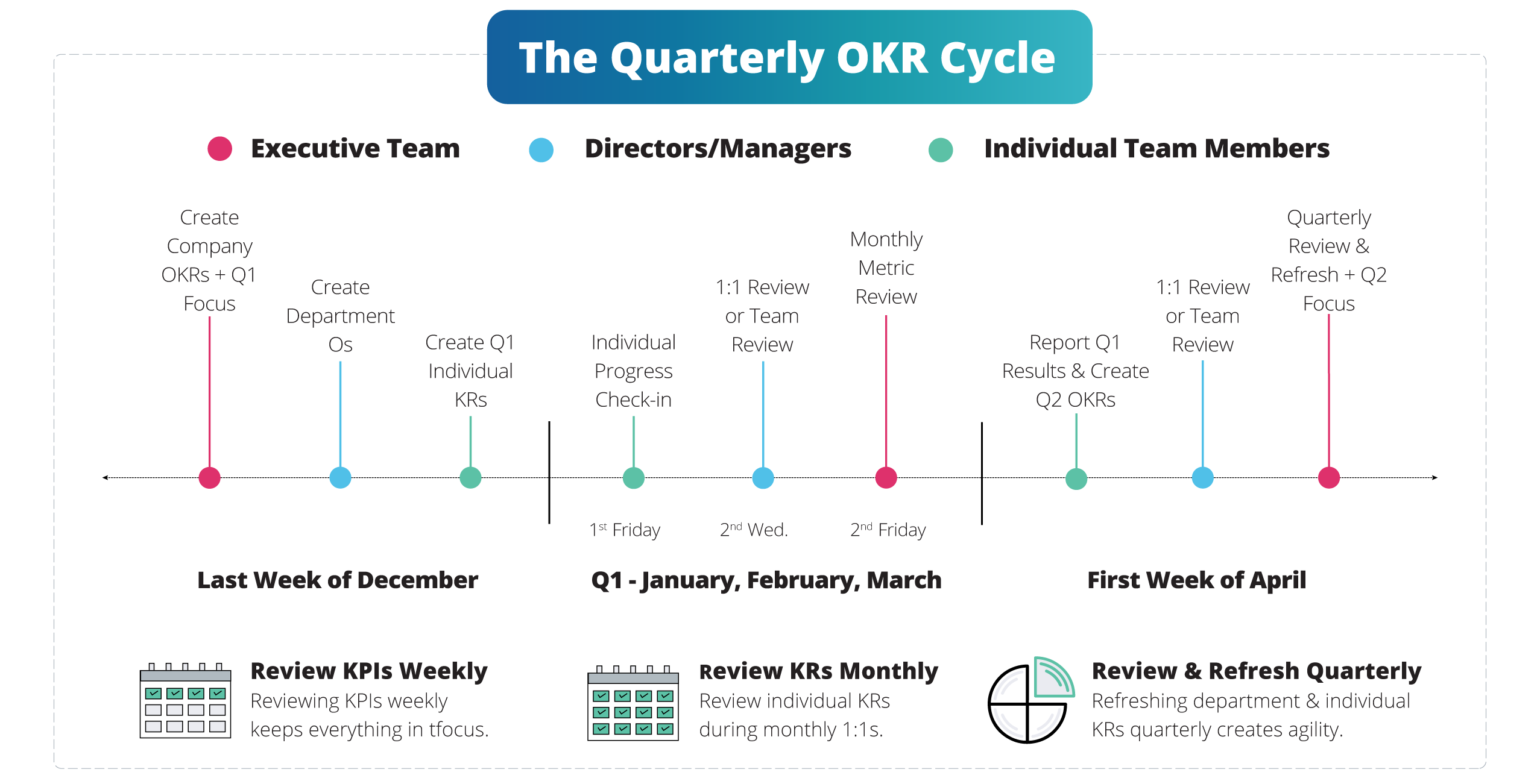
The Types of Meetings Used to Review and Adapt Your OKRs
There are three types of meetings (and one optional meeting) used for the OKR agile planning cycle. Each meeting plays an important role to keep your team focused and aligned.
#1 Annual Company-Wide Priority Setting
This isn’t just our traditional annual planning retreat. Instead, you’ll set company-wide annual strategic priorities or objectives for the year aligned to your 3(ish)-year vision of success. The difference is that you’re setting annual objectives and then creating quarterly results to achieve that Objective.
Tip:
When you set your annual priorities/Objectives, you should also review your previous annual performance. But you need to make sure annual meetings aren’t the only time you’re reviewing your plan and providing a refresh. That should be done quarterly.
#2 Quarterly OKR Reviews and Refresh
Quarterly OKR reviews are designed to review your performance, articulate focus for the next 90 days, and adapt and refresh your OKRs. We consider these quarterly OKR reviews non-negotiable for the agile planning process.
Tip:
The most successful monthly check-ins review your core OKR and KPI metrics.
*OPTIONAL* Weekly KPI Reviews
We recommend integrating a KPI review into your regularly scheduled operation meetings, either organization-wide or by department, whichever works best for you. These weekly meetings show where there is momentum and where there are drags, clarifying the priorities for your team over the next 5 to 7 days.
Tip:
Don’t create a new meeting if you want to review performance weekly. Integrate it into another standing weekly meeting as a dedicated agenda item.

OnStrategy’s OKR Software to Align Teams & Contributors
OnStrategy is the only OKR software that connects long-term business strategy with your OKRs to help your organization thrive. Our OKR software makes it easy for your teams and individual contributors to create, manage, and track their OKRs.
OKR Consulting & Coaching
Our OKR Consulting Services put an expert on your team to help build an agile plan. We can coach you through the entire planning process, or we can facilitate your planning sessions and build a complete agile strategic plan for you.

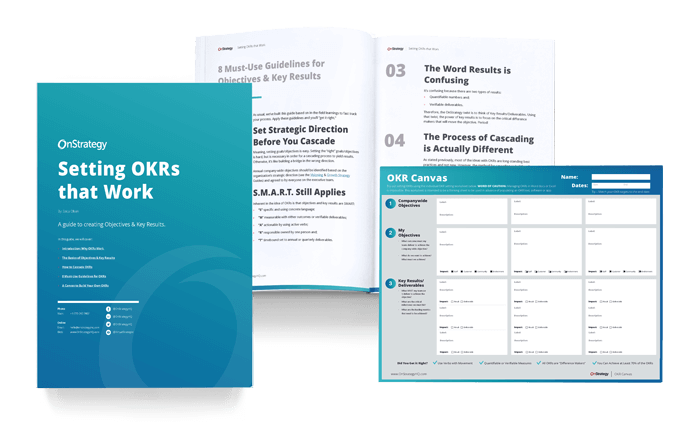
Guide for Setting OKRs that Work
How do you set OKRs that work? We’ve created an end-to-end guide that covers the basics of creating OKRs; how to write them, how you can use them to create a plan you can execute, and a canvas for you to develop your own Objectives and Key Results.
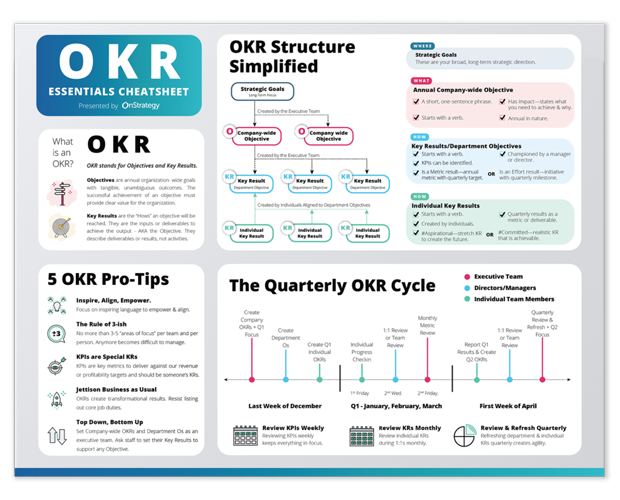
OKR Essentials Cheat Sheet
Trying to make OKRs work in your organization? Don’t miss our free cheat sheet guide for building and refreshing your OKRs including 29 pro tips from our work with clients.
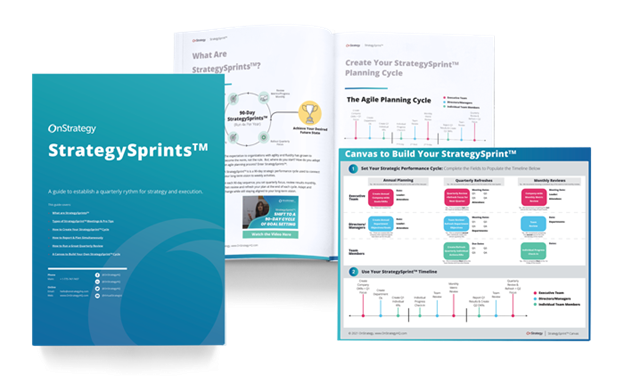
Run a StrategySprintTM—A Free Guide to Establish a Quarterly Goal/OKR Cycle
The best part of the growing popularity of OKRs (Objectives & Key Results) is how this practice creates agility because it’s based on managing implementation and planning in quarterly increments.
Whether you use OKRs or goals, tap into this free guide to learn how to establish a quarterly review cadence to stay focused keep your plan front-and-center.
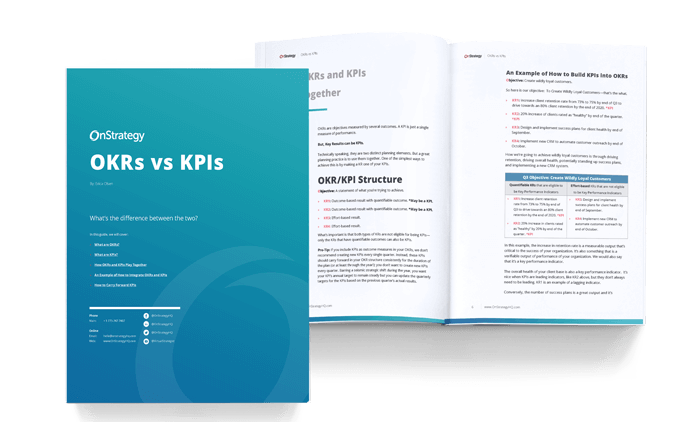
OKRs vs. KPIs: A Downloadable Guide to Explain the Difference
What’s the difference between OKRs and KPIs? In our free downloadable guide, we’ll show you how to integrate and simplify these two powerful planning elements.
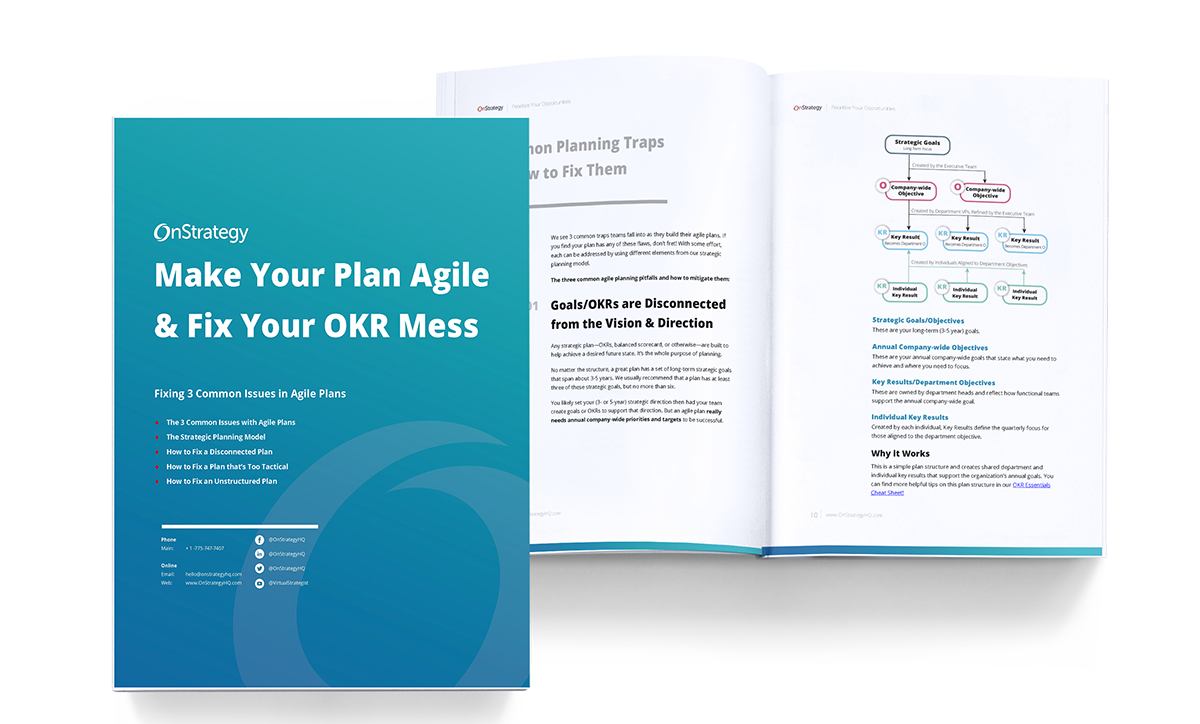
Guide to Make Your Plan Agile & Fix Your OKR Mess
Agile planning and OKRs have undeniably changed the way organizations plan—for good reason: keeping your team aligned and focused on a quarterly cycle has a long list of benefits over the traditional annual planning cycle.
How can it go wrong? And what happens when it does? In this guide, we’ll help you fix common issues we see with OKR plans.
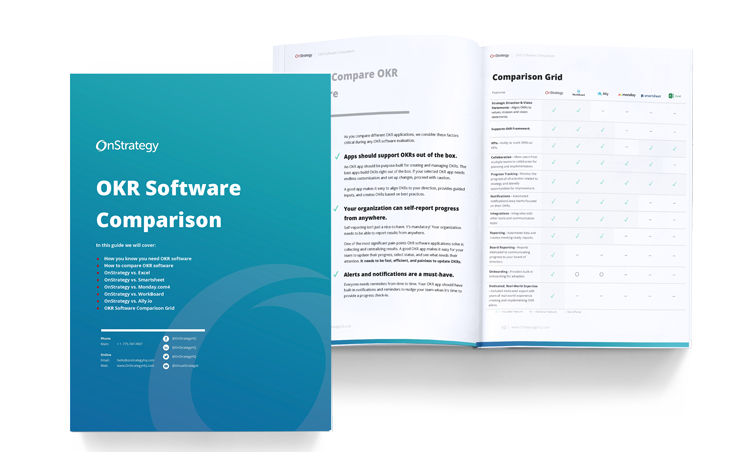
OKR Software Comparison Guide
OKRs have a higher success rate when they’re backed by a purpose-built application.
But in a sea of choices, how are you supposed to decide which OKR app is best for your organization?

How Google Uses OKRs and Why Our Approach is Better
Trying to make OKRs work in your organization? Don’t miss our free cheat sheet to guide you through building and refreshing your company OKRs, including 29 pro tips from our work with clients.

What are OKRs (Objectives and Key Results)? OKRs that Work (Part 1/6)

How to Write OKRs (Objective and Key Results). OKRs that Work Part 2/6

Video – How to Cascade OKRs. OKRs that Work (Part 3/6)

How to Score OKRs – OKRs that Work (Part 4/6)

How to Create an OKR Cycle – OKRs that Work (Part 5/6)

Pick an App to Manage Your OKRs (Part 6/6)

OKRs Fail Without a Vision

How to Fix Your OKR Mess

Why Team OKRs are Better

Goals vs. OKRs vs. KPIs

Transform Your OKRs from Good to Great

OKR vs. KPI: What’s the Difference Between the Two?
The acronym OKR stands for Objectives and Key Results. OKRs consist of Objectives, the “what” must be achieved, supported by 3 to 5 Key Results, which describe “how” we will achieve the Objective.
Key Performance Indicators track the core performance of your business. Key Results can also be Key Performance Indicators. Read the full post on OKRs vs KPIs.
An OKR model is a framework for setting objectives that are achieved through a set of quarterly key results. We recommend organization or department objectives be annual in nature. Key results that support those annual objectives are created and refreshed quarterly.
Objectives and Key Results in business is a framework to create a set of unambiguous outcomes that are achieved through inputs our deliverables in quarterly increments. In other words, objectives are “what” your business wants to achieve, and Key Results are “how” you’ll achieve those outcomes.
First, start with writing annual objectives that support your organization’s long-term vision of success. Great objectives:
- Are a short, one sentence phrase.
- Start with a verb.
- Have impact—stating what you need to achieve and why.
- Are annual in nature.
After your objectives have been written, we recommend creating 3-4 Key Results to support the achievement of that outcome. Great Key Results:
- Start with a verb
- Are championed by a manager at the department level, or owned by an individual at the individual level.
- Are aspirational – a stretch goal. Or, the Key Result is committed–a realistic key result that is achievable.
- Articulate a deliverable or have a quantifiable measure of success.
There are many reasons OKRs fail; three common reasons include OKRs are not connected to your long-term vision, not using a dedicated OKR software app, and not reviewing or refreshing OKRs at least quarterly.













